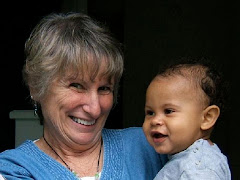Friday, December 17, 2010
What Do Elephants and Humans Have in Common
On the news last evening there was a segment about the Elephant Orphan Project: http://www.sheldrickwildlifetrust.org/asp/orphans.asp It was all about this amazing project in Africa that has been going on for year to save elephants who are orphaned because of severe drought or poaching. What struck me most were the stories of the relationships between the elephants and their human caregivers. We know that humans are hard wired through the brain to be in relationship, it turns out that the elephant shares that wiring with humans. The caregivers in this compound take care of these young elephants until they are developmentally ready to be on their own. At that point they take them out of the compound to join elephant herds. And contrary to what you might think, the elephants are ready to return to "wild life". I can't help but think that the nurturing that is provided by humans has the same physiological components that elephant parents provide to their calves. The Sheldrick Wild Life Project was started when a young elephant had to be left by his mother because he would not move on with the herd as she was asking him to do...had he not been found by Mr. Sheldrick and nurtured and I mean that in the human sense of taking care of young children he would have died. He needed to be in relationship. Part of the story that was told, was of a young calf who Mrs. Sheldrick had cared for by herself. She left the compound to go on vacation and the young calf died from grief. It was at that point that a change was made in that no single person provides the care of a calf, but there are shifts of caretakers round the clock and they all provide the same schedule and routines, but it is not just one person, so when someone has to leave, another steps in and the calf is already use to several caregivers. And yet, the elephant calves remain in the same environment with the same routines and the same caregivers to assure continuity of caregiving and continuity of relationship.
Subscribe to:
Post Comments (Atom)



No comments:
Post a Comment
I really look forward to both your questions and comments.